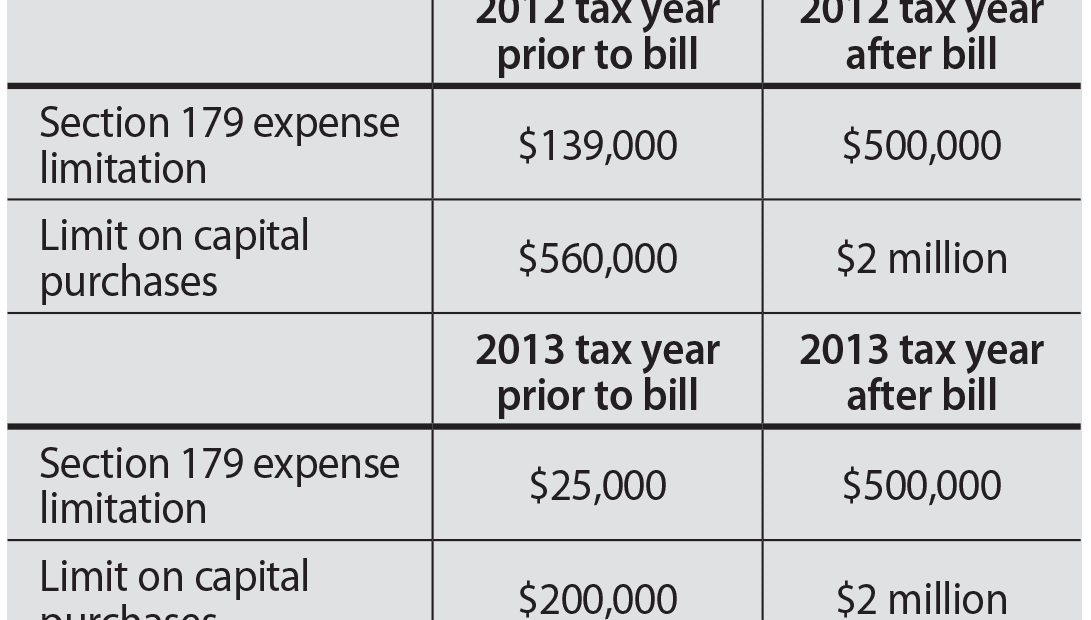
Depreciating Assets in Your Company
Understanding Changes from the American Taxpayer Relief Act of 2012
As you may know, one of the fastest-changing tax laws deals with deductions for the depreciation of assets acquired during the year.Congress is continually adjusting, changing, and, quite frankly, confusing us with continual depreciation-rule amendments. Lawmakers say this is all intended to stimulate the spending habits of companies. However, at the end of the day, it causes confusion to the business owners, internal accountants, public accountants, salesmen, and anyone else who tries to remember the actual deprecation rules from year to year.
To help you transition from prior rules to the current rules under the new American Taxpayer Relief Act of 2012, a comparative summary has been provided below. Understand that the new rules listed are as of the date of this publication and, as always, are subject to change.
• Section 179. The deduction limit was increased with the Small Business Act of 2010 and extended thereafter with the addition of the American Taxpayer Relief Act of 2012. This deduction applied to both new and used capital equipment and ‘off-the-shelf’ software. You generally need taxable income in order to take this deduction, unlike bonus depreciation, which can be taken regardless of taxable income (i.e., you can generate a taxable loss with bonus deprecation).

Be aware that Section 179 limitation rules state that, for every dollar spent over the capital purchase limit, there is a dollar-for-dollar reduction in the deduction. That means, in 2012 and 2013, if you spend more than $2.5 million on qualified items, your Section 179 deductions have been completely phased out.
• Bonus depreciation. The 2012 American Taxpayer Relief Act has extended the 50% first-year depreciation under Code Sec. 168K. The qualified assets need to be acquired and placed into service before Jan. 1, 2014. It is available only on new equipment — meaning its first use by anyone (qualified leasehold rules are discussed later). In addition, there is no capital purchase limit on spending like in Section 179 rules. In 2012 you can deduct the first 50% of the asset cost as bonus depreciation; the remaining basis is then depreciated under normal rules. In 2011, the bonus depreciation was 100% of the asset cost, effectively allowing a full and immediate deduction.
One drawback is that most states do not recognize bonus depreciation, and you cannot take the additional expenditure. You may need to weigh this against the fact that, for state purposes, most states allow Section 179 deductions to the extent of the federal limit.
In 2011, qualified leasehold improvements, qualified restaurant property, and retail improvements were allowed to use a reduced depreciable life of 15 years. With the new 2012 relief bill, this is extended to anything placed into service after Jan. 1, 2012 and prior to Jan. 1, 2014; the extension allows for the 50% bonus depreciation and 15-year depreciable life.
• Auto and truck depreciation. Various rules dictate what you can deduct:
• Passenger autos: the maximum deduction 2012 is $11,060.
• Trucks and vans: the maximum deduction in 2012 is $11,160.
• Heavy SUVs used 100% for business: uses are eligible for 50% bonus. A SUV is considered heavy if it has a gross vehicle weight rating of more than 6,000 pounds but less than 14,000 pounds.
Additionally, a heavy SUV qualifies for Section 179 expensing of up to $25,000. (As a planning tool, you would be able to take bonus of 50% of the cost first, and then take the Section 179 of $25,000).
• Many vehicles, which by their nature are not likely to be used for personal purposes, qualify for a full Section 179 reduction in cost. They include the following:
— Heavy non-SUV vehicles with an open cargo area of at least six feet in interior length (like a full-size pickup truck);
— Vehicles that seat nine-plus behind the driver’s seat (like shuttle vans); and
— Vehicles with a fully enclosed driver’s compartment/cargo area, with no seating available behind the driver (basically a classic cargo van).
As stated previously, these favorable bonus depreciation provisions are scheduled to expire on Dec. 31, 2013. If you wish to take advantage of these provisions, you should plan to have the qualifying items acquired and placed in service by then. After that date (unless the laws are changed), there will be no more bonus depreciation. In addition, after 2013 the Section 179 deduction rules are scheduled to revert to the 2003 limit of $25,000 total deduction on $200,000 of qualified additions.
If you have any questions regarding depreciating assets, be sure to consult your tax advisor.
Dan Eger is a tax associate for the Holyoke-based public accounting firm Meyers Brothers Kalicka, P.C.; (413) 322-3555; [email protected]






